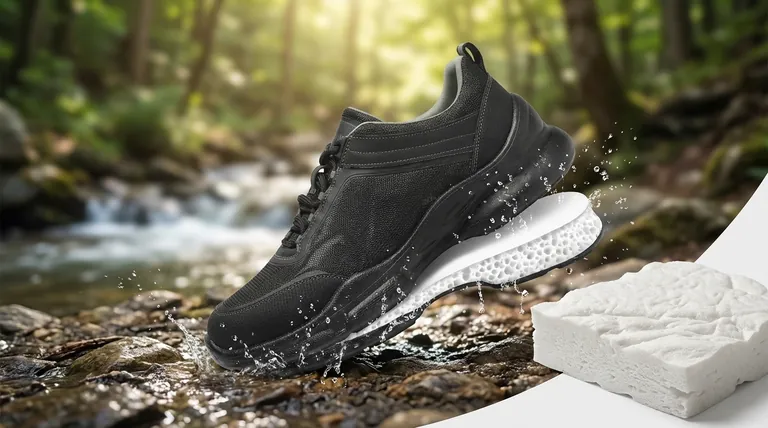At its core, EVA (Ethylene Vinyl Acetate) is a foam material prized in footwear for three primary properties: lightweight cushioning, significant flexibility, and inherent water resistance. It is a copolymer that can be processed into a closed-cell foam, resulting in a soft, rubber-like material that effectively absorbs impact.
The central takeaway is that EVA provides exceptional immediate comfort and lightness, making it ideal for many athletic and casual shoes. However, this comes at a direct trade-off with long-term durability and structural support, as the foam compresses and loses its responsiveness over time.

The Core Properties of EVA Foam
To understand why EVA is so ubiquitous, we need to look at its fundamental characteristics and how they translate to the experience of wearing a shoe.
Unmatched Lightweight Cushioning
EVA is composed of thousands of tiny gas-filled bubbles trapped within the plastic. This structure makes the material incredibly light, reducing the overall weight of the shoe and minimizing fatigue for the wearer.
Inherent Flexibility
The material is naturally soft and flexible, allowing the shoe to bend and move with the natural motion of the foot. This enhances comfort and provides a less restrictive feel compared to stiffer sole materials.
Effective Shock Absorption
The foam structure is excellent at absorbing and dissipating impact forces generated during activities like walking and running. This property helps protect joints from the stress of repeated impact.
Water and Element Resistance
As a closed-cell foam, EVA does not absorb water. This makes it a reliable material for midsoles and even entire shoe constructions (like sandals or clogs) that need to resist moisture and dry quickly.
Understanding the Trade-offs: The Limitations of EVA
No material is perfect. While EVA excels in providing lightweight comfort, its weaknesses are just as important to understand when evaluating footwear.
Compression Set: The Loss of "Bounce"
This is the most significant drawback of EVA. Over time and with repeated impact, the foam cells get crushed and do not fully return to their original shape. This phenomenon, known as a compression set, is why EVA midsoles feel less cushioned and supportive after a few hundred miles of use.
Limited Structural Support
The very softness that makes EVA comfortable also means it offers less resistance to twisting forces (torsional rigidity). For activities requiring high stability, like hiking or court sports, pure EVA midsoles may not provide enough support to prevent foot rolling without additional structural elements.
Traction on Wet Surfaces
When used as an outsole material, EVA itself can be slippery on smooth, wet surfaces. For this reason, many high-performance shoes use an EVA midsole for cushioning but incorporate a more durable, high-traction rubber outsole for reliable grip.
How to Apply This to Your Purchase
Your goal determines whether EVA's properties are an advantage or a liability. Use these guidelines to make a more informed choice.
- If your primary focus is lightweight daily comfort or casual running: Shoes with a prominent EVA midsole are an excellent choice for their immediate cushioning and minimal weight.
- If your primary focus is long-term durability or rugged trail use: Seek out shoes with denser midsole materials like Polyurethane (PU) or those that combine EVA with a robust, full-coverage rubber outsole.
- If your primary focus is stability for court sports or overpronation: An EVA midsole is standard, but ensure the shoe also features firmer support structures, like a TPU shank or a dual-density medial post.
Understanding this balance between lightweight comfort and eventual compression empowers you to select footwear that truly aligns with your performance needs and expectations.
Summary Table:
| Property | Benefit | Common Use in Footwear |
|---|---|---|
| Lightweight Cushioning | Reduces shoe weight, minimizes fatigue | Athletic shoes, casual sneakers |
| Flexibility | Moves naturally with the foot for comfort | Sandals, everyday walkers |
| Shock Absorption | Protects joints from impact | Running shoes, insoles |
| Water Resistance | Dries quickly, resists moisture | Sandals, clogs, beach footwear |
Need high-performance EVA footwear for your brand?
As a large-scale manufacturer, 3515 produces a comprehensive range of footwear for distributors, brand owners, and bulk clients. Our production capabilities encompass all types of shoes and boots, including advanced EVA formulations for optimal comfort and durability.
Contact our experts today to discuss your custom footwear needs and leverage our manufacturing expertise.
Visual Guide

Related Products
- Wholesale Breathable Training Shoes Custom Athletic Footwear Manufacturer
- Wholesale Durable & Breathable Training Shoes for Custom Brands
- Lightweight Breathable Training Shoes for Wholesale & Custom OEM Manufacturing
- Wholesale Modern Comfort Shoes with Dial Closure for Private Label & Bulk Orders
- Wholesale Breathable & Cushioned Training Shoes Custom Factory Production
People Also Ask
- Why are running shoes and walking shoes not interchangeable? Avoid Injury with the Right Footwear
- How do athletic shoes with non-slip features differ from regular ones? Discover the Grip Advantage
- What are the benefits of athletic-style work shoes? Boost Comfort and Safety for Your Team
- How do non-slip athletic shoes differ from regular athletic shoes? Discover the Grip Technology
- What materials are best for athletic activities in warm climates? Stay Cool with Moisture-Wicking Fabrics



















